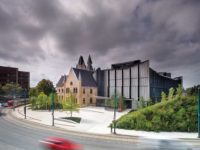San Francisco
'When I was looking for an apartment, I saw the facade and immediately called my real-estate agent,' says Mark Chila, a resident of 616 20th Street in San Francisco. 'I was lucky: the condominiums were almost sold out.' In designing the south elevation of a 16-unit housing block in the Central Waterfront area near Pier 70, architect Stanley Saitowitz created vertical fins of fiber-cement and glass panels as a brise-soleil to shield the interiors from glare. But the knife-pleat array also gives the trim five-story building an arresting visage'a reinterpretation of the historic bay window'in the polyglot area known as Dogpatch.
Saitowitz and three colleagues had originally purchased the 5,525-square-foot property to develop themselves. After he had designed it and got the various governmental approvals, the foursome decided to sell the project to Tipco Construction, which built it. Between October and December 2013, the two-bedroom condominiums sold out at an average of $775,00 per dwelling, not including two priced at a below-market rate to fulfill the city's affordable-housing requirement. (These went for about $220,000 each.)
One reason the occupants responded so quickly to the design could be the plan's efficiency'a Saitowitz trademark. One resident, Amir Azari, a marketing manager, says, 'The plan is the best. It was marketed as a one-bedroom condo with a den, but [the den] can serve as a second bedroom because of the sliding doors.' For his part, Chila, an art director for an ad agency, says about his spare, high-design interiors, 'I am a minimalist, and Stanley did a great job maximizing the space.' Sliding etched-glass pocket doors divide the bedrooms (or bedroom and den) from the living/dining area. At the core of each unit is the 'pod,' consisting of an elongated kitchen facing the living/dining area and, behind it, the bathroom. Here a small corridor separates a closet at the rear of the kitchen from the linear bathroom, and internally connects one bedroom to the other room.
Whereas the facade's sawtooth profile, oriented to the bay, helps expand the sense of space within the units facing south, the north elevation is sheathed in floor-to-ceiling panels of etched and clear glass. Clear-glass panels slide away to allow residents views of a planted courtyard in a nearby housing complex, as well as a garden terrace below. (Balustrades, also of glass, offer a sense of security to those who have seen Alfred Hitchcock's Vertigo once too often.) Saitowitz inventively conformed to a city zoning regulation that requires 25 percent of the site to remain as open space by including the terrace and a stepped-back configuration on the upper floors of the building's rear.
Although the market-rate, 820-square-foot, open-plan apartments are not conceived to accommodate most families, they appeal to the community of young professionals and artists seeking flexible living arrangements for varied households. And they suggest more affordable uses: recently Saitowitz adapted his condominium to a modular scheme for student rental apartments. Working with Nautilus Group, a private developer and builder, he has designed a prototype with five two-bedroom units of student housing in Oakland, near Mills College. After testing the waters with this project, now under construction, Nautilus will turn its attention to a five-stack complex of 80 two- and four-bedroom units near the University of California, Berkeley, campus. If all goes well, the essential goal of expanding the sense of space and light through a well-thought-out plan should remain intact in spite of economic differences between the two forms of housing.
PeopleClient: Tipco Construction Inc. Owner: Private Condominiums
Architect:
Personnel in architect's firm who should receive special credit:
Engineers: Mechanical, Electrical, Plumbing: Robert Wong, PE General contractor: Tipco Construction, Inc.
Photographer(s): Size: 23,000 square feet Construction cost: Withheld Completion date: October 2013 |
Products
Exterior cladding
Windows
Glazing
Doors
Interior finishes Floor and wall tile: Daltile (bath)
Plumbing -Hansgrohe fixtures |











